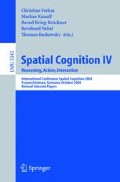Abstract
Diagrams often play an important role in human problem solving. A diagram can make a task more difficult, however, when it obscures important problem features, or requires repeated effort to interpret what it represents. Moreover, the nature and origin of diagrams can be as important as their exploitation during problem solving. This paper chronicles the complex interleaving of visual cognition with high-level reasoning in three subjects. Their diagrams and subsequent verbal protocols offer insight into human cognition. The diversity and richness of their response, and their ability to address the task via diagrams, provide an incisive look at the role diagrams play in the development of expertise. This paper recounts how their diagrams led, and misled, them; how their diagrams both explained and drove explanation; and how a spatial approach reported here can lead to deeper understanding of other simple games.
Access this chapter
Tax calculation will be finalised at checkout
Purchases are for personal use only
Preview
Unable to display preview. Download preview PDF.
References
Amarel, S.: On Representations of Problems of Reasoning about Actions. In: Michie, D. (ed.) Machine Intelligence, vol. 3, pp. 131–171. Edinburgh University Press, Edinburgh (1968)
Anzai, Y., Simon, H.: The Theory of Learning by Doing. Psychological Review 36, 124–140 (1979)
Cheng, P.C.-H.: Unlocking conceptual learning in mathematics and science with effective representational systems. Computers in Education 33, 109–130 (1999)
Cheng, P.C.-H., Simon, H.A.: Scientific discovery and creative reasoning with diagrams. In: Smith, S., Ward, T., Finke, R. (eds.) The Creative Cognition Approach, pp. 205–228. MIT Press, Cambridge (1995)
Cross, N., Christaans, H., Dorst, K. (eds.): Analyzing Design Activity. John Wiley and Sons, Chichester (1996)
Epstein, S.L.: Toward an Ideal Trainer. Machine Learning 15, 251–277 (1994)
Falkenhainer, B.C., Michalski, R.S.: Integrating Quantitative and Qualitative Discovery. Machine Learning 1, 367–401 (1986)
Gelernter, H.: Realization of a Geometry-Theorem Proving Machine. In: Feigenbaum, E.A., Feldman, J. (eds.) Computers and Thought, pp. 134–152. McGraw-Hill, New York (1963)
Hadamard, J.: The Psychology of Invention in the Mathematical Field. Dover Publications, New York (1945)
Hegarty, M.: Mental Visualizations and External Visualizations. In: Gray, W., Schunn, C. (eds.) Proceedings of the 24th Annual Meeting of the Cognitive Science Society, pp. 40–45. Lawrence Earlbaum, CA (2002)
Kaplan, C.A., Simon, H.A.: In Search of Insight. Cognitive Psychology 22, 374–419 (1990)
Kotovsky, K., Hayes, J.R., Simon, H.A.: Why are some problems hard? Cognitive Psychology 17, 248–294 (1985)
Langley, P., Zytkow, J.M., Simon, H.A., Bradshaw, G.L.: The Search for Regularity: Four Aspects of Scientific Discovery. In: Michalski, R.S., Carbonell, J.G., Mitchell, T.M. (eds.) Machine Learning 2: An Artificial Intelligence Approach, pp. 425–469. Tioga Publishing, Palo Alto (1986)
Larkin, J.H.: Display-based Problem Solving. In: Klahr, D., Kotovsky, K. (eds.) Complex Information Processing: The Impact of Herbert A. Simon, pp. 319–341. Lawrence Erlbaum Associates, Hillsdale (1989)
Pascal, B.: Pensées de Pascal. Éditions Garnier Frères, Paris (1964)
Pearson, D., Alexander, G.C., Webster, R.: Working Memory and Expertise Differences in Design. In: Gero, J.S., Tversky, B.T., Purcell, T. (eds.) Visual and Spatial Reasoning in Design II. Key Centre of Design Computing and Cognition, pp. 237–251. University of Sydney, Sydney, Australia (2001)
Poincaré, H.: La Valeur de la Sciènce. Flammarion, France (1970)
Saariluoma, P., Maarttola, I.: Spatial Mental Content and Visual Design. In: Gero, J.S., Tversky, B.T., Purcell, T. (eds.) Visual and Spatial Reasoning in Design II. Key Centre of Design Computing and Cognition, University of Sydney, Sydney, Australia, pp. 253–268 (2001)
Suwa, M., Tversky, B.T., Gero, J.S., Purcell, T.: Seeing into sketches: Regrouping Parts Encourages New Interpretations. In: Gero, J.S., Tversky, B.T., Purcell, T. (eds.) Visual and Spatial Reasoning in Design II. Key Centre of Design Computing and Cognition, University of Sydney, Sydney, Australia, pp. 207–219 (2001)
Tversky, B.T.: Multiple Mental Models. In: Gero, J.S., Tversky, B.T., Purcell, T. (eds.) Visual and Spatial Reasoning in Design II. Key Centre of Design Computing and Cognition, University of Sydney, Sydney, Australia, pp. 3–13 (2001)
Zaslavsky, C.: Tic Tac Toe and Other Three-in-a-Row Games, from Ancient Egypt to the Modern Computer. Crowell, New York (1982)
Zhang, J.: The nature of external representations in problem solving. Cognitive Science 21, 179-217 (1997)
Author information
Authors and Affiliations
Editor information
Editors and Affiliations
Rights and permissions
Copyright information
© 2005 Springer-Verlag Berlin Heidelberg
About this paper
Cite this paper
Epstein, S.L. (2005). Thinking Through Diagrams: Discovery in Game Playing . In: Freksa, C., Knauff, M., Krieg-Brückner, B., Nebel, B., Barkowsky, T. (eds) Spatial Cognition IV. Reasoning, Action, Interaction. Spatial Cognition 2004. Lecture Notes in Computer Science(), vol 3343. Springer, Berlin, Heidelberg. https://doi.org/10.1007/11397977_16
Download citation
DOI: https://doi.org/10.1007/11397977_16
Publisher Name: Springer, Berlin, Heidelberg
Print ISBN: 978-3-540-25048-7
Online ISBN: 978-3-540-32255-9
eBook Packages: Computer ScienceComputer Science (R0)

